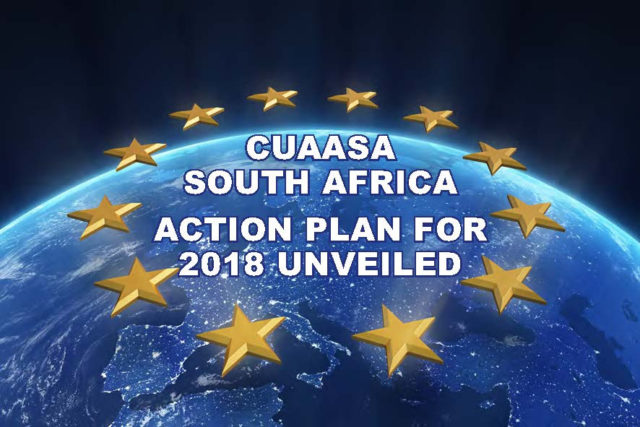The Commercial Unmanned Aircraft Association of Southern Africa (CUAASA), an affiliate of the Commercial Aviation Association of Southern Africa (CAASA), hosted its Annual General Meeting on Saturday 27 January 2018 and set out a plan of action for 2018.
In his opening remarks, Dean Polley, President of CUAASA, emphasised the continuous struggles that the South African RPAS industry faces with regards to obtaining a Remotely Piloted Aircraft Systems Operating Certificate (ROC), a requirement, as per the Civil Aviation Regulations Part 101, that is needed to operate any RPAS in a commercial capacity in South African airspace.
To date, only 20 ROC’s have been issued by the Regulator since the new laws came into effect in July 2015. There are currently around 340 ROC applications pending with the SACAA. The delays and excessive backlog have been attributed to two major factors:
1) The SACAA does not have the required capacity to effectively implement the regulations. “The current system and processes are failing the industry”, said Polley. Current ROC holders are also affected by delays with millions of rands in economic losses being suffered, directly attributable to application processing delays.
2) The second major factor is that every new applicant requires an Air Service License (ASL), which unnecessarily adds to the complexity of applications and the increased timelines for processing.
During 2017, CUAASA, together with CAASA, submitted proposed amendments to the Air Service Licensing Act, which will see the waiver of an Air Service License for RPAS below a weight of 25 kg. Although the amended Act has been approved by all stakeholders, the new Act still has to be signed into law by the Minister of Transport.
“The economic impact has been significant, and according to leading Economist, Dr Roelof Botha, at the beginning of 2017, it was estimated that the cumulative loss in business that the RPAS industry in South Africa has suffered since the enactment of Part 101 amounts to approximately R2 billion. This has been borne out in the dossier prepared by CUAASA representing the losses incurred by legal ROC holders. The estimated contribution to national unemployment was approximately 25,000+ lost jobs”, said Polley.
“CUAASA is preparing a dossier in a legal format, in conjunction with our legal team for presentations to SACAA”, said Polley. “The SACAA has been informed of this and has been advised that there may be legal implications that follow.”
“CUAASA has made it clear that we wish for SACAA to act on the dossier once received in an expedient fashion and to put together a plan to rectify their deficiencies, such that it will not place the industry at risk.”
If there is to be no immediate reaction and an acceptable corrective action by the SACAA, this dossier would possibly be used as the basis for a possible Class Action supported by the documented and quantifiable extensive losses experienced by CUAASA members.
This dossier will be presented to the SACAA, Minister of Transport and the shadow Minister of Transport for appropriate action. “The industry can no longer be expected to carry the losses and accept the rising safety issues where 99.5 % of the industry is not regulated. The industry by mere compliance is at a deficit financially compared with non-complying competitors. Timelines to have SACAA process applications and allow companies to operate are not reasonable compared with other AOC (Manned Aviation) operators and international best practices, and has become a serious impediment to progressing this industry”, said Kev Storie, Chief Operating Officer, CAASA.
“CUAASA has made significant inroads during 2017”, said Polley, “In conjunction with CAASA, amendments to the ASL Act have been successful, in essence, the removal of an Air Service Licenses for sub 25 kg RPAS.
CUAASA has advocated the SACAA for the establishment of an RPAS Liaison Forum to improve drone safety across all users. After a series of engagements and successful meetings throughout 2017, a formal announcement should be forthcoming from the SACAA.
CUAASA has also improved its presence, for everyone interested in Drone related businesses, via an updated website, www.cuaasa.org”, commented Polley.
Looking ahead, the key objectives for CUAASA for 2018 are:
· Increased representation for the industry and continued preparation of the dossier for a potential Class Action lawsuit.
· Continue to push for the revision of RPAS regulations governing the use of sub 2 kg RPAS for commercial use, and the implementation of sUAS regulations.
· Continue to work towards simplifying the regulations, reducing application complexity and simplifying compliance requirements for all RPAS users.
· Maintain a positive relationship with the SACAA via continued and regular meetings through the RPAS Liaison Forum.
· Grow the industry with live demonstrations to the SACAA to demonstrate practical operations relating to night flying operations and integrating RPAS into civilian airspace.
The AGM was concluded with the election of the new Executive for 2018. Four of the ExCo members represent ROC holders, which demonstrates the maturing of this industry representative body. The new Executive Committee consists of Dean Polley (President and CEO of Aerial Vision Africa), Adam Rosman (Vice-President and Managing Director of Aerial Monitoring Solutions), Tom Kruger (Director of Hussar Security & Defense Solutions), Mark Mansfield (Director and Photojournalist of World Airnews magazine), Sean Reitz (CEO of United Drone Holdings), Kevin Storie (COO of CAASA), Nico van Rooyen (CEO of DC Geomatics), Ken Venn (Director of UAV Industries) and Stephen Verheul (Managing Director of Visual Air Productions).
CUAASA is a UVS International Partner Organisation and has a seat on its International RPAS Coordination Council.

